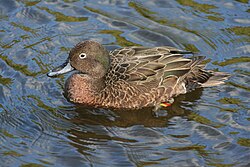Brown Teal
| Brown Teal | |
|---|---|
 | |
| Brown Teal | |
| Conservation status | |
| Scientific classification | |
| Kingdom: | Animalia |
| Phylum: | Chordata |
| Class: | Aves |
| Order: | Anseriformes |
| Family: | Anatidae |
| Subfamily: | Anatinae |
| Genus: | Anas |
| Species: | A. chlorotis |
| Binomial name | |
| Anas chlorotis Gray, 1845 | |
| Synonyms | |
Anas aucklandica chlorotis
| |
The Brown Teal (Anas chlorotis) or New Zealand Teal, is a species of dabbling duck of the genus Anas. The Māori name for it is Pāteke. It was considered to be conspecific with the flightless Auckland and Campbell Teals in Anas aucklandica; the name "Brown Teal" was applied to that entire taxon. The Brown Teal has since been split, recognizing that the insularA. aucklandica and A. nesiotis are good species. In international use, the name Brown Teal is still more common than New Zealand Teal for this bird.
The Brown Teal is rather nocturnal in habit by dabbling duck standards. This seems to be an evolutionary response to the fact that most predators on New Zealand, before humans arrived and brought with them carnivorous mammals, were diurnal birds such as Haast's Eagle or skuas.
It feeds by dabbling and upending, like its relatives. Its diet consists mainly of aquaticinvertebrates like insects and their larvae, or crustaceans. It appears quite fond of mollusks. Small species such as pipi (Paphies australis) and large wedge shell (Macomona liliana) are eaten whole and crushed in the gizzard. For feeding on larger cockles such as Austrovenus stutchburyi (New Zealand cockle), at least some New Zealand Teals have developed a peculiar technique, as of now undocumented in other birds, to force their rather soft bills between the cockle shells and tear out the flesh with a jackhammer-like pumping motion. At night Brown Teal will forage on land some distance from the streams used as a refuge during the day (Worthy 2002).
This species is endangered and occurs only on offshore islands. Formerly, it was widespread on the New Zealand mainland, but it disappeared there due to introduced predators like cats, dogs and rats, which easily preyed on this unwary, weakly flying bird. According to the IUCN categorization as VU D1, fewer than 1000 adult birds remain. The species has recently been upgraded to endangered by Birdlife International (Birdlife 2007), and the change will be reflected in the next update of the IUCN red list.


No comments:
Post a Comment